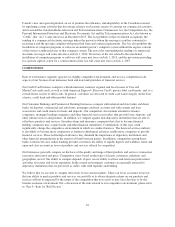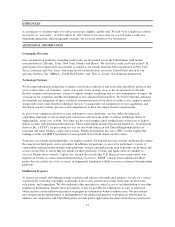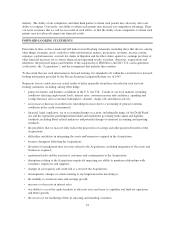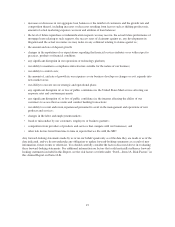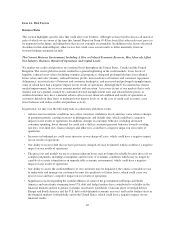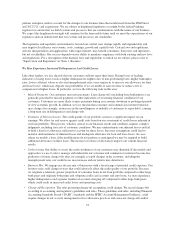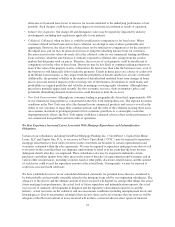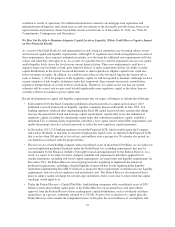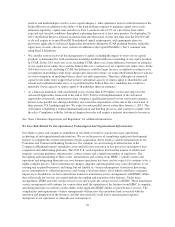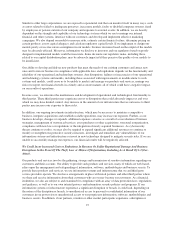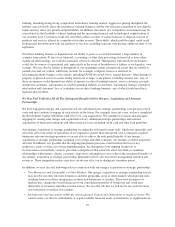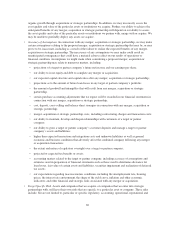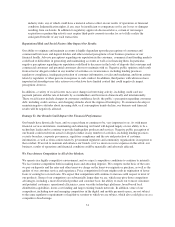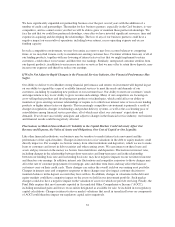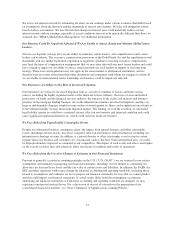Capital One 2013 Annual Report Download - page 43
Download and view the complete annual report
Please find page 43 of the 2013 Capital One annual report below. You can navigate through the pages in the report by either clicking on the pages listed below, or by using the keyword search tool below to find specific information within the annual report.policies enterprise-wide to account for the changes to our business lines that would result from the ING Direct
and 2012 U.S. card acquisitions. We are subject to heightened regulatory oversight by the federal banking
regulators to ensure that we build systems and processes that are commensurate with the nature of our business.
We expect this heightened oversight will continue for the foreseeable future until we meet the expectations of our
regulators and can demonstrate that our systems and processes are sustainable.
The legislative and regulatory environment is beyond our control, may change rapidly and unpredictably and
may negatively influence our revenue, costs, earnings, growth and capital levels. Certain laws and regulations,
and any interpretations and applications with respect thereto, may benefit consumers, borrowers and depositors,
but not stockholders. Our success depends on our ability to maintain compliance with both existing and new laws
and regulations. For a description of the material laws and regulations to which we are subject, please refer to
“Supervision and Regulation” in “Item 1. Business.”
We May Experience Increased Delinquencies And Credit Losses.
Like other lenders, we face the risk that our customers will not repay their loans. Rising losses or leading
indicators of rising losses (such as higher delinquencies, higher rates of non-performing loans, higher bankruptcy
rates, lower collateral values or elevated unemployment rates) may require us to increase our allowance for loan
and lease losses, which may degrade our profitability if we are unable to raise revenue or reduce costs to
compensate for higher losses. In particular, we face the following risks in this area:
•Missed Payments. Our customers may miss payments. Loan charge-offs (including from bankruptcies) are
generally preceded by missed payments or other indications of worsening financial condition for our
customers. Customers are more likely to miss payments during an economic downturn or prolonged periods
of slow economic growth. In addition, we face the risk that consumer and commercial customer behavior
may change (for example, an increase in the unwillingness or inability of customers to repay debt), causing
a long-term rise in delinquencies and charge-offs.
•Estimates of Inherent Losses. The credit quality of our portfolio can have a significant impact on our
earnings. We allow for and reserve against credit risks based on our assessment of credit losses inherent in
our loan portfolios. This process, which is critical to our financial results and condition, requires complex
judgments, including forecasts of economic conditions. We may underestimate our inherent losses and fail
to hold a loan loss allowance sufficient to account for these losses. Incorrect assumptions could lead to
material underestimates of inherent losses and inadequate allowance for loan and lease losses. In cases
where we modify a loan, if the modifications do not perform as anticipated we may be required to build
additional allowance on these loans. The increase or release of allowances impacts our current financial
results.
•Underwriting. Our ability to assess the credit worthiness of our customers may diminish.If the models and
approaches we use to select, manage and underwrite our consumer and commercial customers become less
predictive of future charge-offs (due, for example, to rapid changes in the economy, including the
unemployment rate), our credit losses may increase and our returns may deteriorate.
•Business Mix. We engage in a diverse mix of businesses with a broad range of potential credit exposure. Our
business mix could change in ways that could adversely affect the credit quality of our portfolio. Because
we originate a relatively greater proportion of consumer loans in our loan portfolio compared to other large
bank peers and originate both prime and subprime credit card accounts and auto loans, we may experience
higher delinquencies and a greater number of accounts charging off compared to other large bank peers,
which could result in increased credit losses and operating costs.
•Charge-off Recognition. The rules governing charge-off recognition could change.We record charge-offs
according to accounting and regulatory guidelines and rules.These guidelines and rules, including Financial
Accounting Standards Board (“FASB”) standards and the FFIEC Account Management Guidance, could
require changes in our account management or loss allowance practices and cause our charge-offs and/or
23





